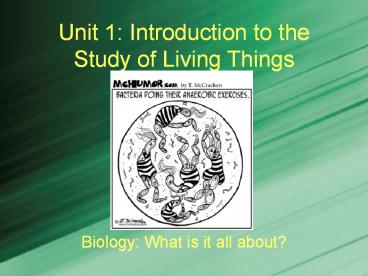Unit 1: Introduction to the Study of Living Things - PowerPoint PPT Presentation
1 / 27
Title:
Unit 1: Introduction to the Study of Living Things
Description:
Unit 1: Introduction to the Study of Living Things Biology: What is it all about? – PowerPoint PPT presentation
Number of Views:264
Avg rating:3.0/5.0
Title: Unit 1: Introduction to the Study of Living Things
1
Unit 1 Introduction to the Study of Living Things
Biology What is it all about?
2
Chapter 1 Biology and Science
- A. What is biology?
- 1. __________ - The study of life.
- The science of life and of living
- organisms, including their structure,
- function, growth, origin, evolution,
- and distribution.
- 2. __________ Any living thing
- 3. Biologist
3
B. Science 1. Scientific Method Scientific
Inquiry - Basic _____________ to follow for
answering scientific questions -
Scientific Inquiry begins with making
_______________ 2. Steps of the Scientific
Method a. State the ____________ b.
Propose a Hypothesis _____________ a
prediction about the possible answer
based on previous knowledge c.
Experimentation _____________ factors
that are manipulated during an
experiment __________________ an
experiment in which only one variable is
changed d. Observations / Results e.
Conclusions f. Repeat the Experiment
4
Watering Plant Experiment
5
3. Scientific Facts a. ___________
information based on experimentation
observations and tests demonstrate basic
information to the scientist b.
_________ explains a certain set of facts ideas
about a specific situation or similar
situation ex ______________________
Theories are changed and modified based on new
scientific evidence c. ______________ once
a theory has been tested many times over
many years and is constantly proven correct
then it becomes a scientific law. ex
____________________
6
Chapter 2 The Biology Laboratory
- What we use and how we use it!
7
A. Scientific Method / Inquiry 1. Defining the
_________________ What are you testing on
what? ex What is the _______ of ________
on ___________? 2. Formulating a Hypothesis
_______________ statement ex If
______ is given to a student, then their
_________ will increase If the
independent variable is changed, then
the dependant variable will change Remember the
hypothesis _________ have to be correct many
great scientific discoveries have been made
because the hypothesis was incorrect. What is
important is that you write the hypothesis in the
correct format. DO NOT use the words
______________________.
8
3. Testing the Hypothesis, Experimentation a.
Independent Variable The __________________
is the factor that the experimenter changes
to see an effect b. Dependant Variable
The _________________ is the factor that is
affected by the independent variable c.
Control The _______________ is the
experimental setup without the independent
variable ___________________________________
______________ d. Control Factors
Control factors are other variable that are
______________ e. Reproducible Procedure
To have a valid experiment the steps of the
procedure have to be _______________________
9
ex What is the effect of sugar on heart rate?
a. Independent Variable ___________________
_________ b. Dependant Variable
____________________________ c. Control
____________________________ d. Control
Factors ____________________________________
_____________ e. Reproducible Procedure
__________________________________________
__________________________________________
__________________________________________
__________________________________________
__________________________________________
etc.
10
4. Observing and Measuring Observations are
the data collect while doing the experiment
Making graphs and charts to organize your data 5.
Analyzing and Drawing Conclusion Inference are
the ideas and reasoning based on the
observation Conclusions relate back to the
hypothesis to explain either why it happened
or why it did not happen 6. Theories and Laws
Every experiment can be made better by repeated
testing or increasing the sample size With
years of repeated testing with similar results
theories and eventually laws can be developed
11
B. Measurements 1. SI Units
______________________________ We use the
metric system because it is based on _______
Converting units is much easier because all you
have to do is move the decimal point.
a. ___________ meter, centimeter,
millimeter, micrometer 1 meter 100
centimeters 1 centimeter 10 millimeters
1 millimeter 1000 micrometers
b. _________ grams, kilograms c.
___________ milliliters, liters, cubic
centimeter (cc) d. ____________ -
Celsius
12
(No Transcript)
13
2. Graphing Graphing makes a picture of the
data Graphing makes it easier to interpret the
data and see general trends
Making Graphs 1. Label the axes. The x-axis
should be labeled with the independent variable
The y-axis should be labeled with the dependant
variable. 2. Scale both axes. Each box has to
represent the same amount. Start at zero and
count by 2s, 5s, or even 10s. DONT UST PUT THE
NUMBERS THEY GIVE YOU! 3. Plot your points.
Circle the points. Connect the points. 4. Title
your graph. 5. Answer any questions based upon
the graph.
14
Amount of Estrogen added to the Diet (grams) Average Number of Eggs Laid
0 4
5 6
10 6
15 7
20 8
25 4
30 1
15
(No Transcript)
16
(No Transcript)
17
(No Transcript)
18
(No Transcript)
19
(No Transcript)
20
(No Transcript)
21
(No Transcript)
22
(No Transcript)
23
C. Equipment
1. Compound Light Microscopes a. ____________
b. ____________ lenses c. ____________ d.
____________ e. ____________ f. Mirror /
Illuminator, Body, Stage, Base
g. __________________ Total Mag Ocular Mag x
Objective Mag 10 x 40 400
h. Resolution Resolution is the ability to
distinguish between 2 different items
24
2. Other Types of Microscopes a. ____________
- 1 lens magnifying lens b. ____________ -
use both eyes, 3D image, used for
micro-dissections c. ___________________
extremely high magnification and resolution
25
3. _____________ Centrifuges separate
materials based on density by spinning very
rapidly
4. ______________ Tissue culture is the growth
of cells in the lab
26
5. ________________ Chromatography is the
separation of pigments (colors) in a sample
27
5. ________________ Gel electrophoresis is
the separation of DNA pieces using
electricity. It make a DNA fingerprint ?
specific pattern































